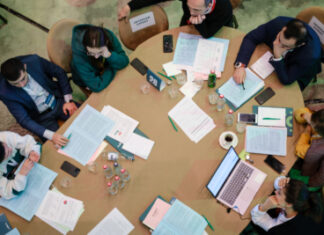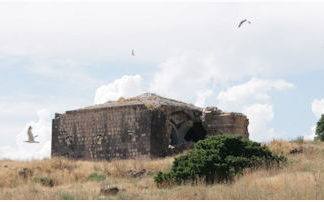By Aram Arkun
Mirror-Spectator Staff
BEIRUT, Lebanon — The Armenians of Hajin returned to their town after World War I thinking that they could rebuild their homes safely under British and French protection. Instead, Turkish Nationalist forces ended up besieging them from March to October 1920. When the town was captured, many thousands of Armenians were killed. The Hajin Compatriotic Union of Beirut, Lebanon, with the support of Haigazian University and some individual donors, organized a series of events in commemoration of these victims on October 15 to 16. These included a photo exhibit, musical performances, a symposium, an evening public concert with fireworks, the preparation of the traditional jidabur (a stew similar to herisa) and, after a requiem ceremony in St. Kevork Church in the quarter of New Hajin of Beirut, a special commemorative meal.
Hajin Armenians from places as far afield as Marseilles and Pasadena came to attend the events, though the majority were from Beirut. The events began on the evening of October 15 with formal speeches by the presidents of the Hajin Compatriotic Union and Haigazian University, respectively Paul Yacoubian and Rev. Dr. Paul Haidostian, as well as the ambassador of the Republic of Armenia to Lebanon Ashot Kocharian. A letter of encouragement from the director of the Armenian Genocide Museum Institute, Dr. Hayk Demoyan, was read.
The main speaker that evening was Dr. Gerard Chaliand, a specialist in guerrilla warfare from France who over decades has personally investigated and written about liberation movements in Africa, the Middle East, the Caucasus, Central Asia, Russia and South America. He has taught courses in major universities around the world and founded in France the Group for the Rights of Minorities. He has served as advisor to the French Foreign Ministry’s Center of Research and Planning from 1983 to 1994 and from 1997 to 2000, was the director of the European Center for Conflict Research. Just as importantly, at least for this conference, Chaliand’s uncle, Garabed Chalian, was the last governor of Hajin.
Chaliand gave an overview of modern Armenian history and nationalism. He felt the Armenian elites, especially, after World War I, were in a “sort of historical myopia” and did not understand what was going on. Context must be understood to avoid becoming its victim, he said. However, at the end, in 1920, the Armenians of Hajin chose to die bravely as warriors instead of surrendering. No other choice was left.
Musical performances by Talar and Lori Yacoubian and Arek Dakessian took place. At least 250 people were present, including several parliamentary deputies and a state minister. The crowd then walked to the Matosian Exhibition Room of the Mugar Building of Haigazian University. There, they viewed the photo exhibit, which consisted of reproductions of printed photos of various aspects of Hajin that were enlarged and displayed on the walls. The photos remained in the hall until October 20.









